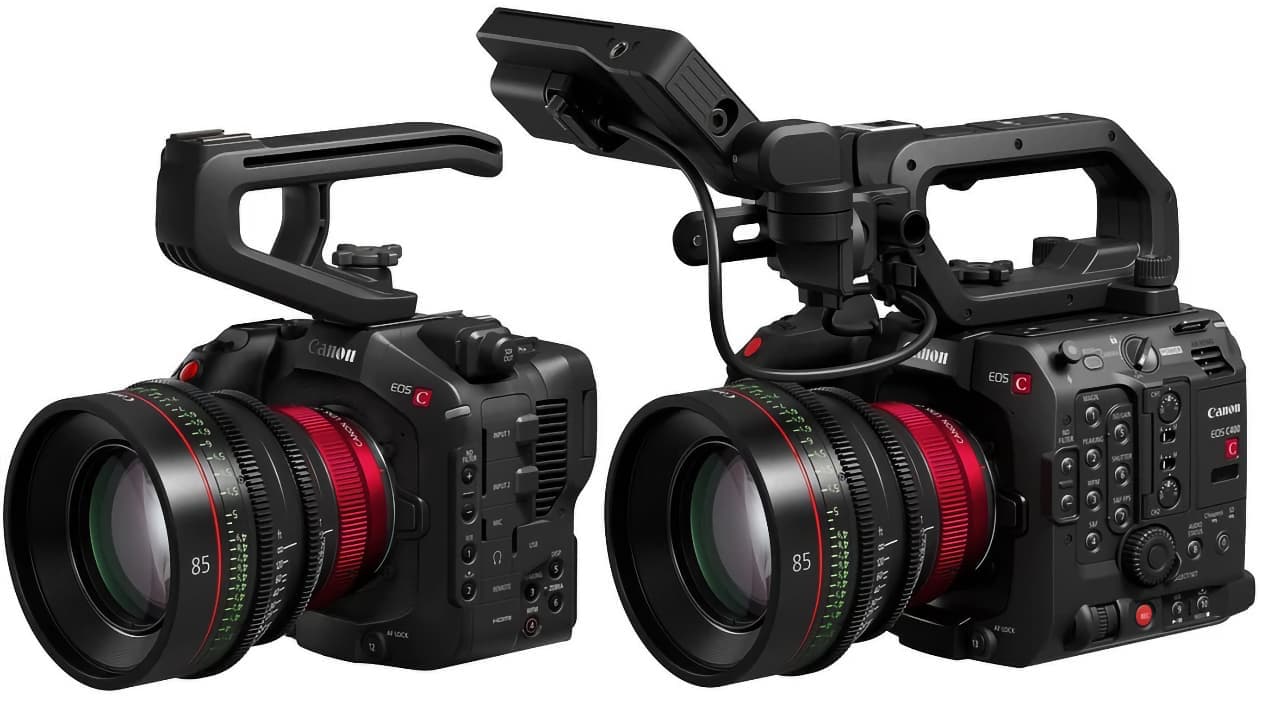
The Canon EOS C80 and Canon EOS C400 both offer powerful features that fit a range of shooting scenarios. Here’s our guide to which one is the right choice for individual production needs.
[sponsored article]
In Canon's Cinema EOS camera range, the EOS C80 and EOS C400 each provide a unique offering for professional content creation. The $7499 EOS C400 is a professional workhorse, with a next-generation full frame BSI sensor, modular design and uncompromising connectivity. The $5499 EOS C80 shares the full frame 6K BSI sensor and expanded connectivity of the EOS C400, but houses this in a compact and lightweight design (taken from the EOS C70).
Both feature Canon's advanced RF-mount technology and intelligent autofocus, but which is right for your production needs? Here’s a detailed look at a range of shooting scenarios, with expert insights from Aron Randhawa, Senior Product Specialist at Canon Europe.
1. Filming for cinema

When you're recording a cinematic production, image quality is always the prime consideration.
The EOS C400 and EOS C80 will both serve you well with their full frame 6K BSI CMOS sensors. "The BSI (Back-Side-Illuminated) sensor design increases the light gathering efficiency of the sensor to deliver higher sensitivity, with 16 stops of dynamic range, less noise, and reduced rolling shutter," says Randhawa.
In addition, the full frame sensor gives you that characteristic cinematic look from your lenses, with an expansive field of view and shallow depth of field.
On both cameras, 4K footage is oversampled from the 6K sensor, delivering superior quality compared to native 4K. Both also offer a range of professional recording formats, including 12-bit Cinema RAW Light. "This means they provide full colour and pixel information to give you maximum flexibility in post-production," Randhawa says.
Both also use Canon's advanced RF mount, enabling the use of the growing range of high-quality RF lenses, including the Canon CN-R Primes. They also support PL mount lenses (including anamorphic lenses and Canon's acclaimed Sumire Primes) via a PL-RF Mount Adapter.
The EOS C80 has excellent low-light performance and connectivity, while the EOS C400 is the more versatile of the two thanks to its form factor, with a modular design adaptable to different shooting styes, maximum recording quality with high bitrate options, and extensive professional connectivity built in.
2. Live broadcast

Live broadcast scenarios often entail unpredictable lighting conditions. The EOS C400 and EOS C80 both offer triple base ISO in all recording modes – for example, 800, 3,200 and 12,800 ISO when shooting in Canon Log or RAW. This means you can set a different amplification level for the best signal-to-noise ratio, or use auto-switching and let the camera select the optimal setting for the conditions.
"This is an absolute game changer for live events and low-light shooting," says Randhawa.
In a live broadcast setup, connectivity is also a key requirement. The EOS C80 offers a wide range of I/O options including HDMI Output, 2x mini-XLR, Mic In, Remote, and Timecode, as well as 12G-SDI, which Randhawa notes "is particularly useful when transmitting 4K signals across long distances in live events."
The EOS C400 usefully adds Genlock and Return Input. "These are both invaluable features for live broadcast, with Return Input ensuring camera operators can view the live feed from the production switcher, as well as Genlock synchronising all the cameras in a multi-camera workflow,” Randhawa says.
Both have built-in Wi-Fi and Ethernet, allowing for either wired or wireless operation and enabling real-time IP streaming (SRT / RTSP) and remote control via Canon's XC Protocol using Canon's Multi-Camera Control app or compatible devices such as the Canon RC-IP1000 controller.
These options allow for the easy control of multiple cameras for broadcast, sports and other events. Both cameras' capabilities can also be expanded via various accessories in their Multi-Function Shoe, such as an XLR adapter or shotgun microphone.
3. Filming fast-paced sports

When you're filming fast-moving action, a high frame rate can be a big benefit. Both cameras can shoot at up to 120fps in 4K or, if you need it, up to 180fps in 2K/Full HD.
Just as useful is the powerful autofocus capability. The EOS C400 and EOS C80 both incorporate the latest Dual Pixel CMOS AF II,1 including evolved EOS iTR AF X subject tracking. This provides improved autofocus acquisition and tracking across 100% of the sensor, as compared to approximately 80% horizontally and vertically in the previous iteration of the technology. This results in intelligent head tracking that continues to track a subject, even when they look away from the camera. It also offers animal as well as people detection.
4. Filming news and reportage

For news gathering, interviews, live events or even weddings, a lightweight and nimble camera is ideal. The same applies if you need to film inconspicuously or simply have to carry your kit to remote locations. The EOS C80 is just below 1300 grams (2.87 lbs), and the EOS C400 is still relatively light for its form factor at approximately 1540 grams (3.4 lbs).
Both are designed to be easy to build up or build down, and both have a removable handle unit. The EOS C400 comes with a 3.5-inch touchscreen LCD monitor with a secure locking USB-C connection, which can be attached direct to the camera body or using a three-axis adjustable mount.
"Having a modular design and detachable LCD, handle and grip makes the EOS C400 the most flexible camera for rigging for various shooting styles," Randhawa comments.
In the EOS C80, the fully-articulated 3.5-inch LCD touch panel is built-in, with an all-in-one design making it ideal for solo shooters, he adds.
When filming handheld or on the move, image stabilisation can be vital. Both models offer in-body five-axis Electronic IS; combining this with optically stabilised IS lenses will ensure the most stable cinematic footage.
They are also both compatible with Canon's Content Transfer Professional (CTP) app for journalists to upload footage with detailed metadata straight to the newsroom. "This can make all the difference in the competitive field of news reporting," Randhawa notes.
5. Filming for virtual productions, VFX and VR

Finally, Canon Cinema EOS cameras on the whole are also well-suited to emerging, cutting-edge industry workflows such as virtual production and VR content capture. With compatible Cinema/RF lenses, both the EOS C400 and EOS C80 support high-speed lens metadata output to Canon's Live Link plug-in for Unreal Engine, meaning that real-world footage and virtual elements can be effortlessly merged together in virtual production studios.
Randhawa adds that the EOS C400’s Genlock makes it ideal for virtual productions using large LED walls because it can synchronise precisely with the LED refresh rate.
"Both cameras also support frame-by-frame metadata capture with CV Protocol when recording internally," he notes, "which is key for VFX and post-production workflows."
In addition, they are compatible with Canon's breakthrough RF 5.2mm F2.8L DUAL FISHEYE lens, meaning that breathtaking 180° stereoscopic VR content can be captured in 3K per eye using a single camera setup, with Canon's EOS VR System making it more straightforward than ever to create immersive VR video experiences.”
The verdict
When it comes down to it, the differences between the two cameras are small, but they can be significant depending on what you are planning to use them for. The EOS C80 is compact and offers full frame versatility, good connectivity and autofocus, plus outstanding low-light performance. The EOS C400 has the most versatile form factor for a range of professional workflows, including live broadcast and virtual production. Having visibility into what use you will put the camera to is the secret to making the right choice between them.
Tags: Production Cameras Canon


Comments